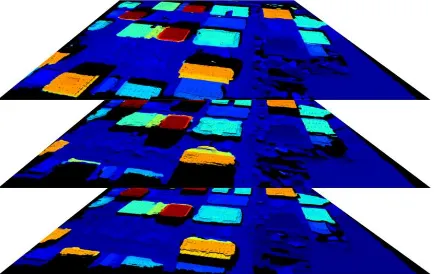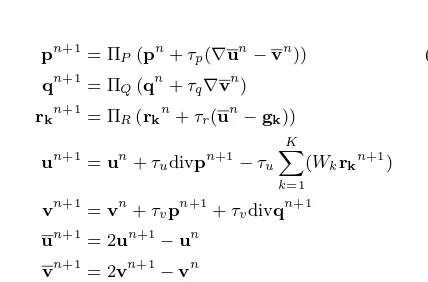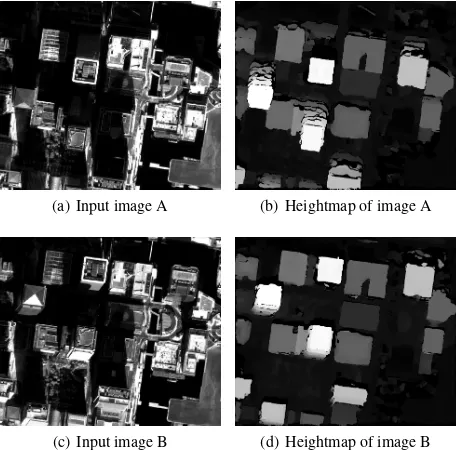FUSION OF MULTI-RESOLUTION DIGITAL SURFACE MODELS
Georg Kuschk, Pablo d’Angelo
Remote Sensing Technology Institute, German Aerospace Center (DLR), D-82234 Wessling, Germany (georg.kuschk , pablo.angelo)@dlr.de
Commission WG I/4
KEY WORDS:DSM, 3D Reconstruction, Data Fusion
ABSTRACT:
This paper proposes an algorithm for fusing digital surface models (DSM) obtained by heterogenous sensors. Based upon prior con-fidence knowledge, each DSM can be weighted locally adaptively and therefore strengthen or lessen its influence on the fused result. The proposed algorithm is based on variational methods of first and second order, minimizing a global energy functional comprising of a data term forcing the resulting DSM being similar to all of the input height information and incorporating additional local smoothness constraints. By applying these additional constraints in the form of favoring low gradients in the spatial direction, the surface model is forced to be locally smooth and in contrast to simple mean or median based fusion of the height information, this global formulation of context-awareness reduced the noise level of the result significantly. Minimization of the global energy functional is done with respect to theL1norm and therefore is robust to large height differences in the data, which preserves sharp edges and fine details in the fused surface model, which again simple mean- and median-based methods are not able to do in comparable quality. Due to the convexity of the framed energy functional, the solution furthermore is guaranteed to converge towards the global energy minimum. The accuracy of the algorithms and the quality of the resulting fused surface models is evaluated using synthetic datasets and real world spaceborne datasets from different optical satellite sensors.
1 INTRODUCTION
Digital surface models (DSM) are a basic component for many applications, such as orthophoto creation, mapping, visualisa-tion and 3D planing in many applicavisualisa-tion fields. Today, many technologies for DSM generation exist, such as airborne LiDAR, SAR interferometry and automatic image matching, each result-ing in a different quality and characteristics. As a result, multi-ple datasets of DSMs are available for most parts of the earths landmass and it is therefore interesting to fuse these into a sin-gle, higher accuracy DSM. Depending on the underlying satellite characteristics like ground sampling distance (GSD), the DSMs capture different parts of the scene in different quality, which even can be mutually exlusive to some extent. For example, high resolution sensors like World-View 2 with a GSD of 0.5m per-form very well in urban areas, whereas the results in forest areas are somewhat moderate. In contrast, Cartosat-1 with a GSD of 2.5m performs quite opposite in these areas. Even with the same sensor, a different exposure time can drastically alter the results in shadow areas or in highly reflective areas like glaciers. Apart from the obvious aspect of fusing multiple different DSMs, some techniques produce multiple DSMs for the same area, which need to be fused as well. For example, many multi-view image match-ing techniques are based on matchmatch-ing individual stereo pairs and later fusing these stereo pairs into a common height model, see e.g. (Hirschmueller, 2008), (Kuschk, 2013), (Rumpler et al., n.d.).
Our work focuses on the fusion of 2.5D DSM grids, with a res-olution from several decimeters to a few meters. DSM fusion has been considered by various authors previously. The simplest method is based on weighted averaging of two or more height maps (Schultz et al., 1999), (Reinartz et al., 2005). As weighted averaging cannot deal with outliers or blunders in the DSMs, a median fusion is often used for multi-DSM fusion, sometimes followed by weighted averaging of the inliers (Hirschmueller, 2008). Both median and weighted averaging does process each pixel independently, and thus cannot take into account the local
surface shape, which is usually very regular. Applying additional mean or median based filtering spatially reduces the amount of noise to some extent, at the cost of blurring potentially sharp edges. An example for context aware fusion algorithms is the use of sparse representations (Papasaika et al., 2011), where a DSM patch is computed as a sparse linear combination of dictionary DSM patches. Except for median fusion, pixelwise error maps are required by weighted averaging and sparse representations. A comparison between weighted averaging and sparse represen-tations (Schindler et al., 2011) found that the quality of the fused DSMs is mostly determined by the quality of these pixel based error maps.
Figure 1: Fusion of multiple DSMs covering the same area
2 METHOD
As most computer vision problems are generally ill-posed (e.g. image segmentation, stereo reconstruction, image fusion), addi-tional regularizers (constraints) are needed for physical meaning-ful solutions. In our case of 2.5D image fusion, these regularizers are the assumption of the world being locally planar, meaning that height value of each pixel of the DSM depends on its local context and e.g. is highly unlikely to have a signifanctly differ-ent height value than its surrounding pixels. This smoothness constraint typically is implemented by minimizing the gradient of the resulting DSM. Together with the data term this results in large systems of partial differential equations (pde) which are time-consuming to solve and special care has to be taken to still allow for strong discontinuities along building edges and to not smooth them over. The design of the energy functional has to be chosen such that it is convex in the variable to solve for. Other-wise it would be very hard for non-linear minimization method to not getting stuck in local minima.
In recent years, Total Variation based methods (TV) for minimiz-ing energy functionals have seen a lot of attention in the research community. One reason is that these algorithms are very well-suited for parallelization and, together with the recent advances of GPU-based computational power, lead to efficient algorithms, solving these optimization problems efficiently. And as the en-ergy functional of our image fusion problem can be written in a convex formulation, the solution is globally optimal.
2.1 TV-L1Fusion
Based upon the ROF-model for image denoising (Rudin et al., 1992), the extension for multiple image fusion, together with re-placing the quadratic data term by the more robustL1norm as in (Pock et al., 2011) is written by
are given asgkand the scalar factorλdbalances the impact of
the smoothness term and the data term. While this model al-ready provides good results by smoothing flat areas and preserv-ing sharp discontinuities, it suffers from the so-called staircaspreserv-ing effect. This effect is a direct result of the regularizer, whose as-sumption is a locally planar world - where planar unfortunately refers to locally fronto-parallel. This staircasing effect of the TV-L1algorithm is visible in Figure2.
2.2 TGV-L1Fusion
To overcome the fronto-parallel assumption of TV-L1 minimiza-tion, (Bredies et al., 2010) introduced the mathematical model of Total Generalized Variation (TGV) as a higher-order extension of Total Variation which favors the solution to consist of piecewise polynomial functions (e.g. fronto-parallel, affine, quadratic). Es-pecially the 2nd order is of high interest, as it forces the solution to consist of piecewise planar functions. In contrast to the TV-L1model, now also including slanted planes. (Pock et al., 2011) applied this model to DSM fusion, resulting in the following op-timization problem
Now, before the variation of the imageuis measured, a 2D vector
fieldvis subtracted from the gradient ofu. An affine surface in
the imageuhas a constant gradient∇u, so by coupling and
min-imizing|∇u−v|, the vector fieldvwill also be constant and it’s
gradient∇vtherefore zero. Regarding our overall optimization
problem, this means that the energy term will be lower, if affine functions can be found in the image, whereas non-affine function get additional penalties by|∇v|. The valuesλs, λa, λdare scalar
weights and balance the impact of the smoothness term, the affine term and the data term.
2.3 Weighted TGV-L1Fusion
When fusing DSMs it is desirable to weight the input DSMs on a per pixel base, to be able to incorporate additional prior knowl-edge into the fusion process. This prior knowlknowl-edge for example can be based on the different sensor characteristics used to gener-ate the DSM, confidence measures during the 3D reconstruction process itself, information about occluded and therefore unknown areas in each DSM, etc. We therefore extend Equation2with a weighting matrixWkfor each input DSM
min
This optimization problem (and the ones in Equation1and2) is very parameter dependent, as we need to adapt the influence of the data termλdmanually for datasets with different ranges of
g(ki,j) ∈gkas well as for a different numberKof input images. To achieve independence of the data range of the input DSMs, we scale all input data to the interval[0..1]
g(ki,j)=g
independence fromKis achieved by normalizing the influence of the data term w.r.t. the two-image case and using the adaptive
λK d =
2
Kλd (5)
Note that all these extensions and modifications apply to the TV-L1method similarly. In the next section we will go into detail about how to solve these optimization problems numerically.
3 ALGORITHM
To solve for the fused DSMu∈RM×N(in the following written
as stacked vectorRM N×1
) in Equation3, we need to overcome the non-differentiable L1-norm, which complicates any gradi-ent descgradi-ent based minimization scheme. An efficigradi-ent algorithm which elegantly circumvents the differentiability problem of the gradient operator is the primal-dual algorithm of (Chambolle and Pock, 2011).
By applying the Legendre-Fenchel transform we obtain the dual formulation / conjugate of the separate terms as
such that the saddle-point problem in the primal variablesu,v
and the dual variablesp,q,rkwith constraints
P ={p∈R2M N :kpk∞≤λs} (7)
Please note that due to the stacked vector notation, the input weights are denoted as diagonal matricesWkand the
correspond-ing multiplicationWkrkis actually a pixelwise multiplication. The saddle-point problem above can be solved by iteratively per-forming gradient descents on the primal variables and gradient ascents on the dual variables. Applying this primal-dual algo-rithm leads to the following optimization scheme:
do
To ensure the constraints of Equation7, the corresponding prox-imal mappings above are given as
ΠP(p) = p
In the analytical derivation of the primal-dual scheme, we re-quire the gradient and divergence operators to be negative adjoint, such thath∇u,pi=− hu,divpiandh∇v,qi=− hv,divqi.
Therefore we use finite forward differences with Neumann bound-ary conditions for the gradient operators and for the divergence operators finite backward difference with Dirichlet boundary con-ditions. The step sizes of the gradient ascents/descents are bound to the norm of the gradient/divergence operators, see (Chambolle and Pock, 2011), and are set toτu =τp =τr = 1/
The whole algorithm stops, if either the maximum number of iterations has been reached (nIterations = 1000) or the en-ergy change between successive iterations drops below a relative threshold∆EnergyT hres= 0.1%.
Again, the algorithm for the TV-L1fusion is derived similarly.
4 EVALUATION
4.1 Artificial Tests
The first evaluation is done on synthetic data. A given ground truth DSMgis perturbed with noise to simulate different noisy
observations of the scene. Five of these noisy DSMs are then given as input to the fusion algorithms and the accuracy of the output DSMuis measured by the logarithmic signal-to-noise
ra-tio:
In Figure2, visual and numerical results are given, showing a sig-nificantly higher accuracy of the global optimization methods for DSM fusion over simple mean and median based fusion. Please note that we applied mean and median filtering for all height val-ues of a single pixel as well as its neighboring pixels to also in-clude some spatial regularization.
4.2 Unimodal DSM fusion
In our second evaluation, we created 10 different DSMs of the same 1km×1km area of the inner city of London using a stereo reconstruction framework as proposed in (Kuschk, 2013). For this we have a collection of 25 WorldView-2 images, taken from different positions during one pass of the satellite. The ground sampling distance (GSD) of these images are 0.5m and for eval-uation purposes, we obtained a LiDAR measurement of the same area by aerial laser scanning, unfortunately only having a GSD of 1.0m. Two of the satellite images together with the computed heightmaps are shown in Figure3. The 10 selected heightmaps are projected in the same orthogonal UTM coordinate system and the resulting DSMs are again fed into the different fusion algo-rithms. Figure4shows the result of median based fusion ver-sus TGV-L1 fusion, again with a lower noise ratio visible for the TGV-L1 algorithm. The accuracy of the fused DSMs w.r.t. to the LiDAR ground truth is given in Table in the common er-ror metrics Mean Absolute Erer-ror (MAE), Root Mean Square Er-ror (RMSE), Normalized Median Absolute Deviation (NMAD). Here the improvements are hardly detectable at all, with all algo-rithms exhibiting similar numerical results. As of yet we do not have further explanation for these results, but strongly suspect the coarse resolution / GSD of our ground truth data mentioned above (in average we only have 1 LiDAR point covering the area of 4 DSM pixels).
MAE [m] RMSE [m] NMAD [m]
median 1.74 3.89 1.62
TV-L1 1.75 3.65 1.55
TGV-L1 1.69 3.64 1.51
Table 1: London dataset: Accuracy of the fused DSM w.r.t. ground truth obtained by aerial laserscanning (LiDAR)
4.3 Multimodal DSM fusion
(a) Groundtruth data (b) 1 of 5 noisy input images (c) Fusion using pixel based plus spatial mean filtering,SN R= 22.76
(d) Fusion using pixel based plus spatial median filtering,SN R= 32.61
(e) TV-L1fusion,SN R= 39.60 (f) TGV-L1fusion,SN R= 40.32
Figure 2: Comparison of local fusion method versus global optimization methods. Both numerical results and visual appearance show the benefit of the latter ones.
(a) Input image A (b) Heightmap of image A
(c) Input image B (d) Heightmap of image B
Figure 3: London dataset: 2 out of 10 input images and their corresponding heightmaps
WorldView-2 images (GSD=0.5m). Fusion of the different reso-lution DSMs is done by projecting the DSMs into the same co-ordinate frame and setting the weightswk for the invalid pixels
of the coarser resolution to zero. As reference we have LiDAR data with a GSD of about 1.0m. The numerical results of local median fusion and global TV-L1 and TGV-L1fusion are given in Table2, indicating an improvement of both local and global fusion algorithms over the coarse CartoSat-1 DSM, but only the global fusion algorithm improves the result of the high resolution WorldView-2 DSM.
(a) Result of median fusion
(b) Result of TGV fusion
(a) WorldView-2,La Mola (b) WorldView-2,Terassa (c) WorldView-2,Vacarisses
Figure 5: ISPRS dataset: Exemplary WorldView-2 images of the three sub datasets
Algorithm La Mola Terassa Vacarisses
MAE[m] RMSE[m] NMAD[m] MAE[m] RMSE[m] NMAD[m] MAE[m] RMSE[m] NMAD[m]
CartoSat-1 4.82 12.77 2.18 2.80 5.90 1.81 3.76 8.80 2.11
WV-2 4.43 8.31 4.00 2.31 3.66 2.06 3.05 5.00 3.07
median 4.51 10.45 3.03 2.44 4.71 1.79 3.07 6.17 2.49
TGV-L1 4.31 8.11 3.89 2.27 3.61 2.00 2.99 4.89 3.00
Table 2: Results of local median fusion and global TGV-L1fusion for heterogenous sensor data (CartoSat-1 and WorldView-2 satellite images). The first two rows show the accuracy of the unfused DSM of each satellite separately, whereas the two bottom rows show the fusion results of the two DSMs per scene.
5 CONCLUSION
In this paper we proposed global optimization algorithms for fus-ing multi-resolution DSM obtained by heterogenous sensors. These global optimization algorithms are based on adaptively
weighted TV-L1 and TGV-L1 optimization problems, allowing for a context-aware fusion of multiple DSMs. In three different evaluations, both synthetic and real world data sets, a significant improvement of the accuracy was shown with respect to mean and median based filtering methods.
ACKNOWLEDGMENT
The authors would like to thank European Space Imaging (EUSI) for providing the WorldView-2 data of London.
REFERENCES
Bredies, K., Kunisch, K. and Pock, T., 2010. Total generalized variation. SIAM Journal on Imaging Sciences 3(3), pp. 492–526. 2
Chambolle, A. and Pock, T., 2011. A first-order primal-dual algo-rithm for convex problems with applications to imaging. Journal of Mathematical Imaging and Vision pp. 1–26.2,3
Hirschmueller, H., 2008. Stereo processing by semiglobal match-ing and mutual information. IEEE Transactions on Pattern Analy-sis and Machine Intelligence pp. 328–341. semi global matching - das gute und alles zusammengefasste paper.1
Kuschk, G., 2013. Large scale urban reconstruction from remote sensing imagery. International Archives of the Photogrammetry, Remote Sensing and Spatial Information Sciences 5, pp. W1. 1, 3
Papasaika, H., Kokiopoulou, E., Baltsavias, E., Schindler, K. and Kressner, D., 2011. Fusion of digital elevation models us-ing sparse representations. Photogrammetric Image Analysis pp. 171–184.1
Pock, T., Zebedin, L. and Bischof, H., 2011. Tgv-fusion. Rain-bow of computer science pp. 245–258. 1,2
Reinartz, P., dAngelo, P., Krauß, T., Poli, D., Jacobsen, K. and Buyuksalih, G., 2010. Benchmarking and quality analysis of dem generated from high and very high resolution optical stereo satel-lite data. In: ISPRS Symposium Commission I. 3
Reinartz, P., M¨uller, R., Hoja, D., Lehner, M. and Schroeder, M., 2005. Comparison and fusion of dem derived from spot-5 hrs and srtm data and estimation of forest heights. In: Proc. EARSeL Workshop on 3D-Remote Sensing, Porto.1
Rudin, L., Osher, S. and Fatemi, E., 1992. Nonlinear total varia-tion based noise removal algorithms. Physica D: Nonlinear Phe-nomena 60(1-4), pp. 259–268.2
Rumpler, M., Irschara, A., Wendel, A. and Bischof, H., n.d. Rapid 3d city model approximation from publicly available ge-ographic data sources and georeferenced aerial images.1
Schindler, K., Papasaika-Hanusch, H., Schuetz, S. and Balt-savias, E., 2011. Improving wide-area dems through data fusion– chances and limits.1



